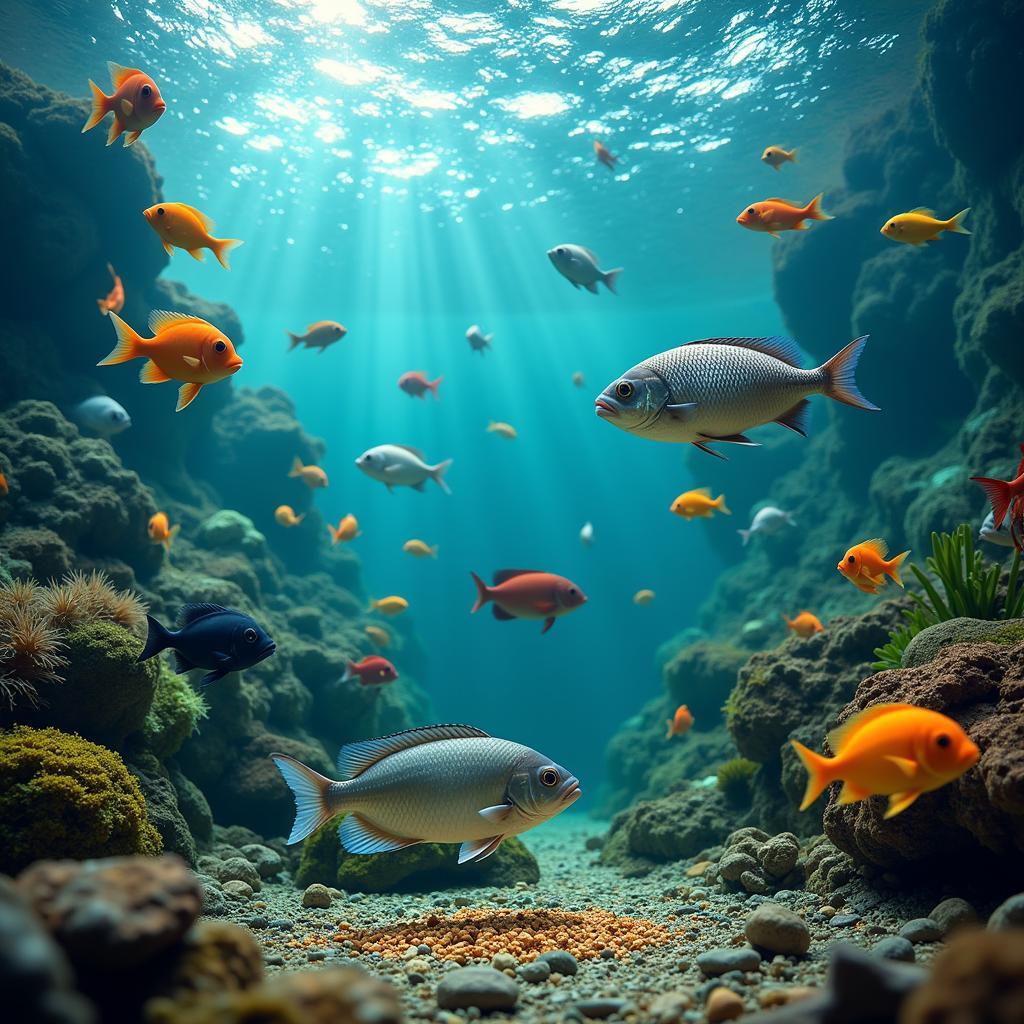Fish Food Small Pellets are a staple in many aquariums, providing a convenient and nutritionally balanced diet for a variety of fish species. But with so many options available, how do you choose the right pellets for your finned friends? This comprehensive guide will dive deep into the world of small pellet fish food, covering everything from understanding your fish’s dietary needs to selecting the best product for optimal health and vibrant colors.
Why Size Matters in the Fish Food Aisle
While it might seem insignificant, the size of your fish food pellets plays a crucial role in their diet. Smaller pellets offer a range of benefits, especially for fish with smaller mouths or those that are pickier eaters.
Here’s why size makes a difference:
- Ease of Consumption: Small pellets are easier for fish to ingest whole, reducing the likelihood of leftover food that can pollute the tank.
- Improved Digestion: Smaller food particles are digested more efficiently, leading to less waste and a cleaner, healthier aquatic environment.
- Reduced Waste: Less uneaten food translates to less ammonia and nitrate buildup in the water, promoting better water quality and fish health.
- Ideal for a Variety of Species: From tiny tetras to juvenile cichlids, small pellets cater to a wide range of fish sizes and species.
Deciphering the Label: What to Look for in Fish Food Small Pellets
 Nutritional Label Breakdown for Fish Food
Nutritional Label Breakdown for Fish Food
Navigating the fish food aisle can be overwhelming, but understanding key elements on the label can help you make informed decisions.
Here’s a breakdown of what to look for:
- Ingredients: The first few ingredients listed are the most prominent. Look for high-quality protein sources like fish meal, shrimp meal, or insect meal. Avoid fillers like wheat, corn, or soy, which offer little nutritional value.
- Protein Content: Fish require a protein-rich diet. Aim for pellets with a protein content of at least 30-40%, depending on the specific needs of your fish species.
- Fat Content: Fat provides essential fatty acids. Look for a moderate fat content, typically around 5-10%.
- Vitamins and Minerals: A balanced blend of vitamins and minerals is crucial for overall health, immunity, and vibrant coloration.
- Additives: Some pellets contain added probiotics for digestive health or color enhancers for brighter scales. Consider these based on your fish’s needs and preferences.
Matching the Menu to Your Fish: Types of Small Pellet Fish Food
 Different Fish Species Enjoying Small Pellets
Different Fish Species Enjoying Small Pellets
Just like humans, different fish have different dietary preferences and requirements. Luckily, the market offers a diverse range of small pellet fish foods tailored to various needs.
Here are some common types:
- Sinking Pellets: Ideal for bottom-feeding species like corydoras, loaches, and some types of catfish.
- Floating Pellets: Perfect for surface feeders like bettas, gouramis, and some species of barbs.
- Slow-Sinking Pellets: Offer a good balance for fish that feed at various water levels.
- Color-Enhancing Pellets: Formulated with natural ingredients like spirulina or krill to enhance the vibrancy of your fish’s colors.
- Growth Pellets: Higher in protein to support the rapid growth of juvenile fish.
Feeding Time Best Practices: How Much and How Often?
Overfeeding is a common mistake that can lead to water quality issues. As a general rule, feed your fish only what they can consume within 2-3 minutes. It’s better to underfeed slightly than to overfeed.
The frequency of feeding depends on the age and species of your fish. Juvenile fish may require multiple small feedings throughout the day, while adult fish typically thrive on one or two feedings per day.
Pro Tip: Observe your fish’s behavior. If they seem lethargic or uninterested in food, you may be overfeeding them.
FAQs: Addressing Common Queries About Fish Food Small Pellets
Can I feed my fish only small pellets?
For many fish species, small pellets can provide a complete and balanced diet. However, it’s beneficial to supplement their diet with a variety of foods, such as frozen foods, live foods, or vegetables, to provide a wider range of nutrients.
How long do fish food pellets last?
Unopened fish food pellets typically have a long shelf life, often up to two years. Once opened, store them in an airtight container in a cool, dry place to maintain freshness.
Can I mix different types of small pellets?
Yes, mixing different types of small pellets can provide a more diverse and enriching diet for your fish. Just ensure that all the pellets are appropriate for the specific species you’re keeping.
Discover More Fish Care Essentials
Choosing the Right Fish Food Small Pellets: A Recipe for Success
Selecting the right fish food small pellets is crucial for the health, well-being, and vibrant colors of your aquatic companions. By understanding the factors discussed in this guide, you can make informed decisions that contribute to a thriving and visually stunning aquarium. Remember, high-quality food is an investment in the longevity and happiness of your fish.
Need assistance with selecting the perfect small pellet fish food? Contact our team at 02437655121, email us at [email protected], or visit us at 3PGH+8R9, ĐT70A, thôn Trung, Bắc Từ Liêm, Hà Nội, Việt Nam. We’re available 24/7 to provide expert guidance and support.